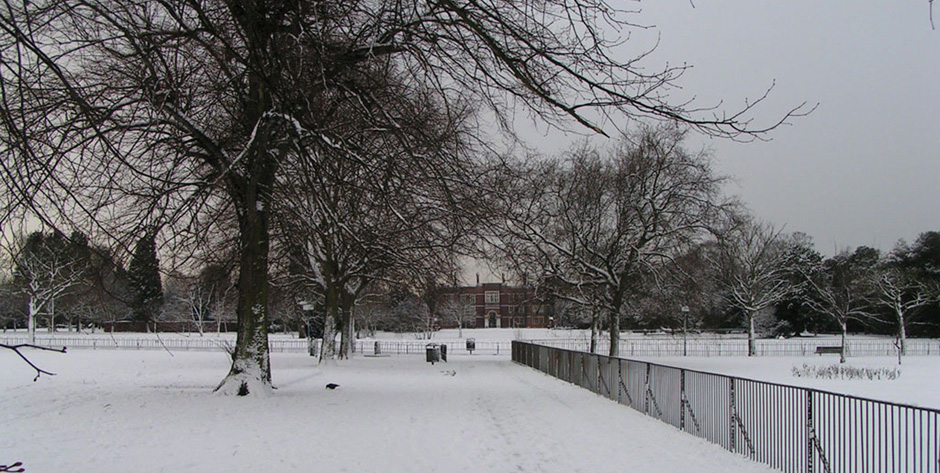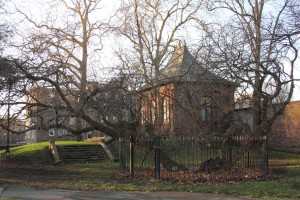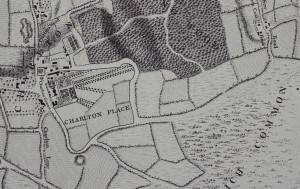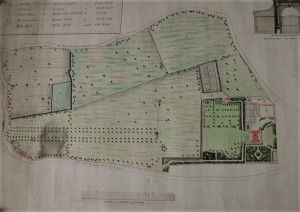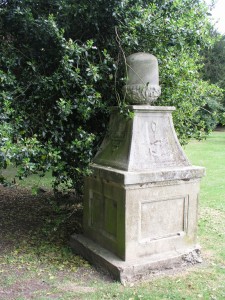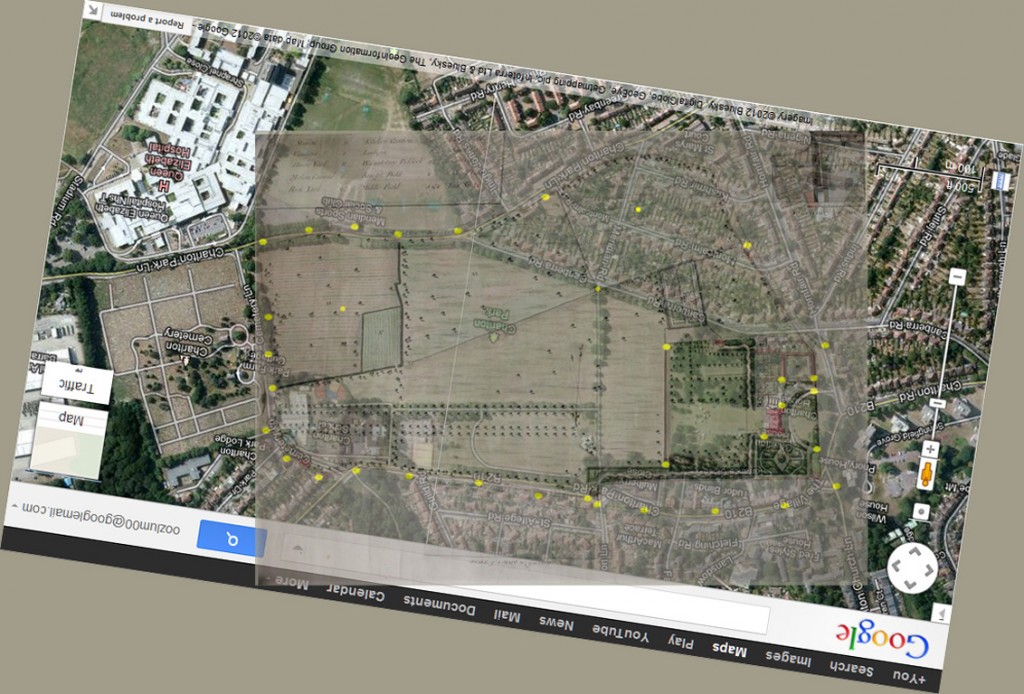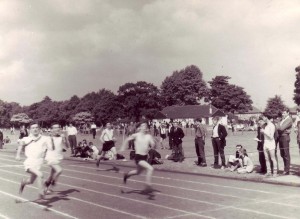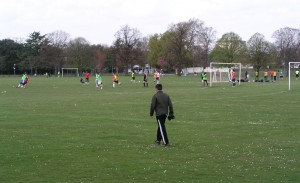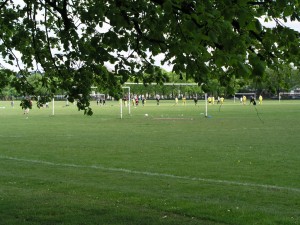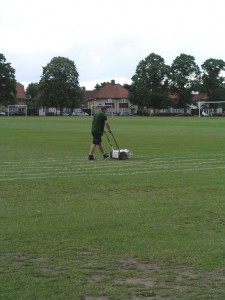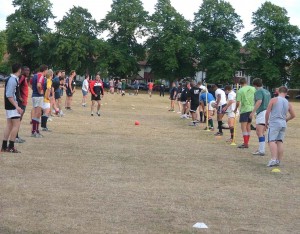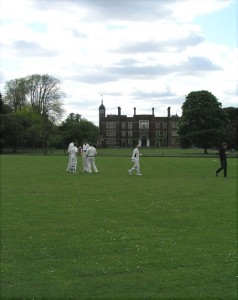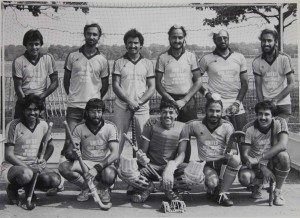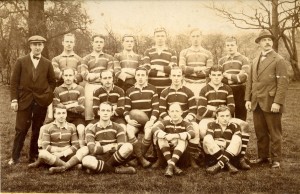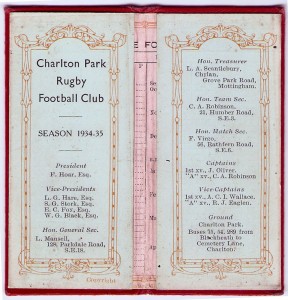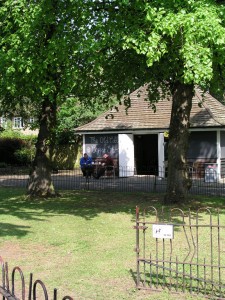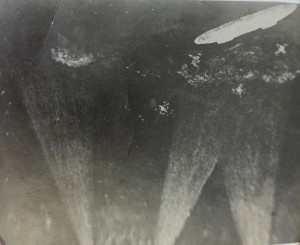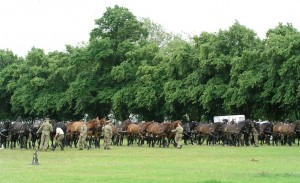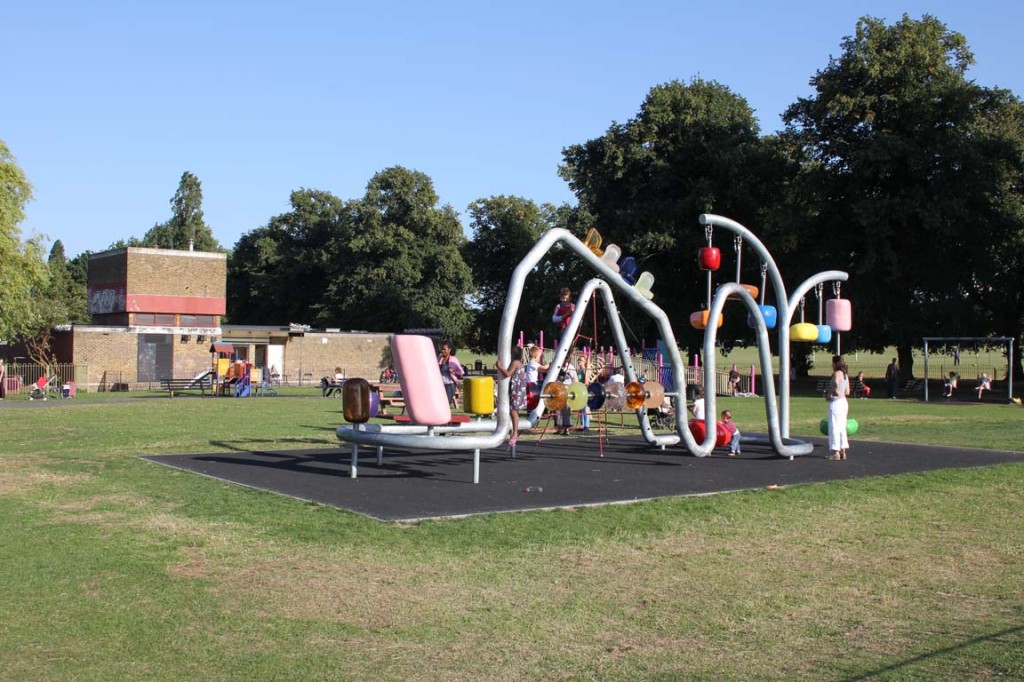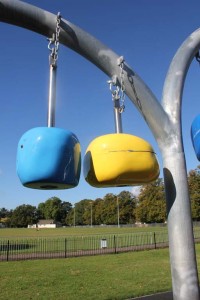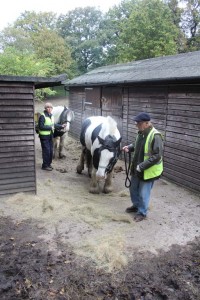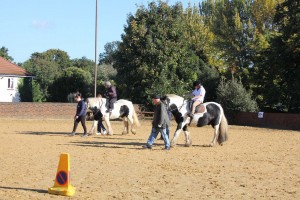Area of Interest
Charlton Park
Audio Extract: Jim Free reflects on how Charlton Park has changed
A view of the Park by J. J. Sexby 1898.
“The gardens show traces of all the many owners, and in spite of the growth of London and its attendant drawback, they are still charming. The house stands in about 150 acres of undulating deer park, with some fine old trees, an avenue of English elms on the east, and one of horse-chestnuts forming the approach on the west. Perhaps the planting of the tulip tree near the present lodge was due to John Evelyn, the friend of Sir Henry Puckering. Evelyn’s liking of tulip trees is well known, and this specimen looks old enough to claim his acquaintance.
The two shattered but grand old Mulberry trees probably date from 1609, when James I encouraged all his subjects to plant them, and tradition points to one as the first brought to England. There is an immense horse-chestnut on the lawn, with a wide spread of branches which are rooted in the ground all round, and among the evergreen oaks and other attractive trees in the ” Wilderness,” a Judas of great age is remarkable.
The small house standing near the road which passes the parish church, known as the ” Guard House,” recalls the time when Prince Henry was living there, and his guard of honour kept watch near the entrance. The stables are just as they were built by Inigo Jones, and the little “Dutch” walled garden which adjoins them on one side is also a pretty relic of those days, and the ‘Gooseberry Garden’ near it is a survival of the same period. A walk overshadowed by tall yew trees stretches across and along the main part of the grounds, and hidden away near its southern end is a delightful rose garden. The beautiful lead fountain in the centre must have been put there by Sir William Langhorne. His initials appear on the leaden tank, and the spray rises from a basin held up by a charming little cupid standing on a pedestal surrounded by swans. The same group appears without the tank in another part of the garden, and there are lead vases and figures, and a cistern dated 1777, which add greatly to the old-world charm which still lingers. Chemical works and sulphurous fumes now work deadly havoc among the old trees, but everything that modern science can recommend is done to preserve them, and young ones planted to keep up the traditions, and bridge over the centuries dividing the present from the days of Prince Henry and his learned and courtly tutor.” J.J.Sexby. The Municipal Parks, Gardens and Open Spaces of London, 1898. Appendix.
A short history
At about the same time as the construction of Charlton House (1612), a red brick wall was built enclosing a small park of approximately 100 acres. As yet, no early plans of the original park and gardens have been discovered, the earliest being the plan by John Rocque of 1741, which shows Charlton House on Charlton Green, next to the church and the hamlet of Charlton.
The placing of the house on an earth dais allowed good views of the patterned formal gardens from the windows of the principal rooms and is a typical feature of the early 17th century. This suggests that the existing terraces at Charlton House are original.The summerhouse sits on a dais of similar height to the house…..At Charlton House, it is assumed that the walls around the formal gardens to the south of the house are original, and would probably have included some kind of knot garden and kitchen garden.
The Rocque plan appears to indicate an avenue of trees where the Lime Walk runs today, along the north wall. Three other avenues radiated from the formal gardens and centred on the House.
The main avenue of trees terminates at an unusual bastion which is situated on the high ground of the river escarpment overlooking the valley with Hanging Wood and the old Roman Camp below. It may be that the Roman camp formed a point of interest in the views out from the park. During the 18th century, the study of antiquity was very popular, and it was common practice to encapsulate a piece of antiquity.
A survey plan by Hill and Bateman of 1765-7 shows that all the formally laid out gardens had been removed with the exception of the walled areas close to the house and the one quadrangular area to the north of the house. This is a clear response to the English Landscape Movement. The Dutch and French influenced geometry and formality of previous generations were removed as the fashion for Arcadian natural parkland predominated among the English aristocracy.
On the village green in front of Charlton House the often rowdy Horn Fair was held on St. Luke’s day (18th October), described by Sandby in 1781 as a “disorderly annual fair or rather rout… with women on that day out vying the men”. In 1825, Sir Thomas Maryon-Wilson, unhappy with the “indecent character” of this fair, succeeded in moving it to Fairfield (a short distance to the north) and enclosing the village green as his own. For this reason, the arch, which was the original gateway to Charlton House, now curiously stands in the middle of the front lawn. At around the same time, Sir Thomas brought back from Italy a Roman stone chest that remained in the garden until the Maryon-Wilson family sold the estate in 1923. In 1828, there were apparently three cypress trees in front of the house that were the remnants of a long row of cypresses; the missing ones replaced by elm trees. In 1840, the garden in front of the house was “formerly thickly enblossomed in yew trees which have been headed down, but would be better removed.” The same source speaks of the garden being in a poor state of neglect. During this time, military review, polo matches, fetes, parties were “almost a daily event.”
The ha-ha was constructed in 1847, only the northern section remains separating the park from the house and pleasure gardens.
To the east of the house an avenue of elms extended beyond the ha-ha, the trees being mentioned by John Evelyn to be large even in the mid 17th century. The article speaks of deer in the park that “lend their graceful form… to the beauties of the scenery.”
On either side of the lawn which stretches from the house up to the ha-ha there were informal belts of trees and shrubs planted in a bold and free style, with winding paths running through, which occasionally opened up at points of interest. Species mentioned are rhododendrons and giant Aucubas in great luxurience. In this part an ancient avenue of yews is mentioned “which is supposed to have been in existence long before the present mansion was built. According to Evelyn there was a fine row of evergreen cypresses then growing there, but all have disappeared save a solitary specimen.” In the same article, mention is made of an over-mature Robinia pseudo-acacia covered in traveller’s joy Clematis; also foxgloves, other “old fashioned plants,” and the well known horse chestnut whose branches had rooted themselves and grown into mature specimens.
The Ordnance survey map of 1896 shows a cricket ground to the far east of the park across from Charlton cemetery. Subsequently Sir Spencer Maryon-Wilson, a lover of outdoor sports, added four tennis courts, two croquet lawns and a polo field within the park.
During the First World War, and until 1923, part of the park was used as an army remount and
training ground which left the place in a deplorable condition. In the period after the War, the rising cost of living and wages made Charlton House and Estate an impractical proposition for Sir Spencer Maryon-Wilson 11 Bt. to continue. The outgoings far outstripped any income. In June 1925, the Greenwich Borough Council purchased Charlton House, Park and Estate, comprising 108 acres for £60,000. About 43 acres were transferred to the L.C.C. in 1926 for £22,250.
Contrary to expectations when turning the park into sports-fields, the soil was light and flinty and thousands of tons of top spit earth and filling material had to be put down to provide good drainage. Over £15,000 was finally spent in laying out the park, leveling and finally seeding the grass, erecting dressing rooms and conveniences.
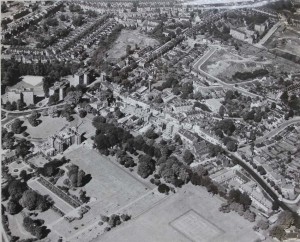
Charlton House aerial view, possibly 1948. The Sports pavilion can be seen in the lower right hand corner. Greenwich Heritage Centre
The park, with eighteen grass tennis courts, putting green, an athletic area with cinder running track and space for many football and cricket pitches was officially opened on July 13th 1929. The following year, modern baths and shower units for both sexes were installed in the pavilion/dressing rooms, and by February 1931, a refreshment hut was erected nearby at a cost of £240.
In the spring of 1942, the Greenwich Borough Council introduced a “Holidays at Home” scheme
and camping was allowed in the grounds.
Prior to the outbreak of the Second World War, trenches were hastily dug in the park as a
deterrent to parachutes or landing aircraft. Large areas were also set aside for growing food, and
some four acres were set aside for temporary buildings to be erected to house bombed out
families. Several tons of iron railings were removed from the perimeter for the national war effort,
but were replaced in 1955.
The cinder running track cost around £2,000 to construct in 1929, and was the scene of many athletic records. In 1969, it underwent conversion to conform to metric and international standards, and to improve the bends, which had been a constant source of concern to the athletes.
The same year, a single storey building containing changing rooms and shower baths was built to the east of the running track for the convenience of players using the cricket and football pitches.
An adventure playground and accommodation for the One O’ Clock Club (for young children) was sited next to this building.
The running track was removed around 2000 and the site now houses a floodlit rugby training field. The original pavilion stands unused. Information gleaned from Greenwich Parks department draft Management Plans. 2008
Editors Note: An amplified version of the notes above the historical changes to Charlton Park can be found in the Charlton Park Management Plan, 2010 – London Borough of Greenwich, located under ‘The Project – Resources’.
Organised Sport
Athletics
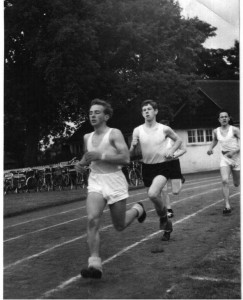
Bermondsey Central Sports Day, Charlton Park 1960. Barry Brady, Ken Pitt, an unknown runner and Arthur Srpingwall.
Extract from Interview Transcript: Steve Smythe remembers Charlton Park in the 1980s
There was a cinder track where the outdoor gym is now and on Tuesday evening they used to get over 50 people, young people. I was in my 20s but they had teenagers and a really vibrant and well-attended running session. So for about the next couple of years I used to come up here every Tuesday night and do some fanatical training round the track. Also we had one-lappers which happens to be one lap of the outside of Charlton Park… then you’d jog up the footpath in the middle… about a mile.
(Steve paid a track fee of about 50p to run with the Cambridge Harriers who have now moved to Sutcliffe Park in, Eltham. He made a lifelong running friend, his namesake, at these sessions. They have run the London Marathon together and are still in the same running club.)
Extract from Interview Transcript: Ron Allison recalls thirty years of training in the Park
(An edited audio version of this extract may also be heard below.)
I joined Cambridge Harriers when I was fourteen I think it was. This was 1956. But there was nobody coached me and I just met this lad who was a postman and we just used to run a lap… jog a lap… walk a lap, run a lap, you know. So we didn’t really know what we were doing and I gradually drifted away and played football and then, when I started going out with my wife – she was only fifteen at the time – and she was just started training with Cambridge Harriers.
What was your wife’s name?
Joan Allison – Joan Page and then Joan Allison. As she got better she got selected at internationals and selected to run for Great Britain at the Mexico Olympics. She was too good for the girls she was running with and not good enough for the lads. So I said to her I’d do my training with her. So, I’d keep myself fit and just carried on playing football as well. So, yeah, that’s how I got into running. Then I got arthritis in ’74 so, there was lots of youngsters there and thinking that I didn’t have a coach when I came up and they were milling around and I thought, ‘Well, I’ll do it to help out.’ And thirty-seven years later I’m still doing it. Yeah, January ’75 I started.
I went on courses but, mainly, just things I’d picked up from watching – there was other coaches like my wife’s coach and there was another coach who was a good standard here as well. One of Joan’s coaches, Norman Hurst, he was more speed-orientated whereas Ron Holman, he was more distance and so I thought, ‘Well, I’ll merge the two together and get the best of both worlds.’ Then I actually went on some courses and then, because my wife was an international, I did sort of trips, warm weather training, so I would go with her on those and watch other coaches and international athletes training and see what they did. Picked up stuff like that.
What’s the difference in training for speed and for distance?
Well, shorter distances and faster, you know, and then you’ve got speed endurance as well which, for the middle distance… because I started coaching, I think it was thirty-two girls. Sixteen were middle distance and sixteen were sprinters so I’ve always coached, you know, that right through and now it’s hundred meters up to marathon.
And the training that you used to do here on the track, was it just training or did you race here as well?
There was races here, yeah. Yeah, there was club champs we used to have here as well but years ago they had the trophy meetings, sort of clubs from Essex and Essex Ladies, yes.Brighton, sometimes, would come up and they had six-a-side competitions. It was just for trophies. Now it’s all leagues.
So it would be a trophy on the day?
Yeah, yeah. I think they might even go back to those days soon with the way athletics is dying. Not so many kids… it’s a tough sport to do because you could go to a meeting and, although the person you run against is an international, he might not be an international in that event but he’s still a blooming good athlete, so you don’t want to get thrashed so you’ve got to train hard just to stay in the race. Yeah, it’s a hard sport. You get so many kids in and out. They come down and they think they can do really well in a short space of time. They don’t and they disappear so… yeah, it’s disappointing really that we don’t get more kids in.
Sutcliffe Park it’s Tuesdays and Thursdays and Saturdays and here we come on Sundays. Stay on the grass and they’ve got the hills in the winter time, we do down there.
And the running track…
It’s gone now. It’s all filled in and they use that as Blackheath Rugby training. Yeah, it’s a shame really.
Did you have any hand in that decision?
No. I would have liked it up here because it was more aesthetic up here…Charlton Park… than it was at Sutcliffe.
You say the hills. Which hills are they?
Woodland Terrace and, in the park itself, you know… it sort of goes up and down – Maryon Wilson Park. And then you’ve got Maryon Park, which has got the swings and we do steps over there as well.
Audio Extract: Ron Allison recalls 30 years of training in the Park
Extract from Interview transcript: Ron Roffey remembers Sydney Wooderson.
When I was at school we used enter athletic competitions – athletic matches and so on – and I used to run in the relay so I used to do a little bit of training on the running track when Cambridge Harriers were there and I can remember Joan and I going up to see Sydney Wooderson, who ran for Blackheath, running in the mile and the people are all around the railings because Sydney Wooderson was going to run during the week. And Sydney with his glasses, you know. Slim, little man trotting around.
I used to do a bit of training there because I was in the 4 x 100 yards and I ran third leg and I used to do my training in there and, of course, we used to do football training in there. We did some running or getting ready for the season. We used to do our running, going around the cinder track… in Charlton Park. I wasn’t the slightest bit interested in running except the school said we want to put something in the national championships for the school for the 4 x 100 yards relay and my pal, he used to run last – he lives in Bexleyheath now – and our first 100 yard man was a chap that lived in Plumstead and now lives in Sydney, Australia and I still can keep in touch with him, we still exchange cards. He ran the first leg.
Extract from Master Athletics by Pat Calnan, 2004: Gordon Hickey
“Looking at the imposing bulk of British Record holder for the M70’s shot Gordon Hickey, it seems hard to believe that he was once the Southern Counties high jump champion, was coached by Sir Arthur Gold and trained with the Royal Ballet
The 70 year old, has been competing for Blackheath & Bromley Harriers AC for 49 years during which he has metamorphosed from one the country’s top high jumpers to head the age group rankings for the shot and throws pentathlon.
Highlight of his career as a high jumper was winning the Southern title. “I must have jumped 6 foot 2 inches over 30 times but then towards the end of my career I cleared 6 foot 3 on a grass run up.” He does wonder what he would have jumped using a tartan runway…………….
One of his last high jump competitions saw him return to the straddle as just as the jumpers were about to start the event at Charlton Park a lorry pulled up and took the mat off to another higher League Division match at Sutcliffe Park. They were left to land in the sand, an opportunity turned down by some of the field but accepted by Hickey with some aplomb as he won the competition” . Read the whole article in the Archives
Football
Extract from Interview Transcript: Steve Smythe remembers training his infant in the snow.
He was about eighteen months and when it snowed in the winter of 2010, on a dark evening he insisted we come out to Charlton park to play football and what I remember about that day is that we were out playing football in the dark, in the snow, and Manchester United canceled their match because of the snow and I said to myself. “That’s dedication you know.” Eighteen months and he’s out training in the dark in the snow.
Extract from Interview transcript: Ron Roffey remembers Sunday football.
Charlton Park… my main memories of Charlton Park was football. I used to play football for the school, of course, but my main memories of Charlton Park was playing for a club that was formed when I was seventeen. When I was on the verge of leaving school I was friendly with a number of lads… still with my friend, Peter, in the pub… that lived in Harvey Gardens and two of them went to school with me and there was a man in Harvey Gardens who lived right opposite the entrance to Charlton football ground, in one of those houses. It was decided that we were going to set up a football team of us lads and the team was called Valley Celtic. He got us lads together and we started and it all came about because he came over one evening. We were having a kick-about on this piece of land that is now Prentiss and he put it to us. “ Why don’t you get yourself organised and have a proper organised…” and he decided he would be our manager.
And as a result of that the club was set up. We used to meet in his house. Club night was a Friday night. We all congregated in his little front room, all us big lads and we decided to set up. One of the boys’ mums made the shirts and all the socks were knitted and so on. He organised pitches on Charlton Park. That was, probably the first time I played organised football, in Charlton Park.
We played on Sunday. It was in the Metropolitan Sunday League. This was when Sunday football was outlawed. If you played Saturday football – Sunday football was not permitted. It was not recognised by the F. A. or local football associations and if you were caught playing on Sunday and you played on the Saturday then you could be suspended and not play football. You could play Sunday but if you played Saturday you were in dire trouble if somebody spotted you playing on Sunday. That was a regulation, that Sunday football was not officially recognised.
For example, Valley Celtic, although it started off with us lads, became very successful. We started off in the Third Division of the Metropolitan Sunday League. It was called the Metropolitan Sunday League and in four seasons we were in the Premier Division. We won every division the first time we were there and because we became so successful we attracted people – good players – from other clubs who wanted to come and play for us and we had a guy that played for Leyton Orient playing for us. We had several guys that played in the Kent League, Maidstone United, Sheppey and so on and they were playing Sunday football and they played under assumed names because we all had to sign a card with our name on it.
So I mean, when we played in Charlton Park this chap – he used to play inside-forward, a very clever player – he was a part-time professional and he worked in Johnson and Phillips and he got paid £10 a week during the playing season and £5 a week during the close season. This is when the season started in September and finished in May, not 24/7 as it is now. He got paid £5 a week for going over to train at Leyton Orient, for doing nothing. He used to have his job in Johnson and Phillips, go and train at Leyton Orient two or three times a week in the evenings I suppose, because he was a part-time professional, and he got £5 for doing that. And then on Sunday he’d appear for us and he’d be George Jones because I mean, I’ve heard people saying, “That’s Gerry Germany… plays for the Orient. What’s he…?” (Laughs). Anyway, so that’s how… that was my main remembrances of Maryon Park. That was our home ground.
Extract from Interview Transcript: Bernard Ashley remembers a special match
(An edited audio version version of this extract may also be heard below.)
As part of ILEA, we just knew that we could use the park. Now this was in the days before Heads had financial responsibility for schools – local government of schools – and, as you know, you were sent the next teacher. When you had a vacancy they sent you someone and it wasn’t until later when local management of schools came in that Heads were doing their own thing in terms of interviews and in terms of making sports arrangements and so on. So, for the first – I was there for nearly twenty years – for the first, I would say eight or nine years at least, we just knew that on a Wednesday and a Friday afternoon we walked the children round for football. I’d walk the boys round for football. The girls were doing netball and so on in the school playground. We did, once a year, apply to the park to have our sports day there, which was in the big oval, which is now a rugby training ground. So we had a sports day there once a year, which we did apply for. And for the use of the pavilion for making teas and lavatory facilities and so on.
I mean, what you could do then – Health and Safety on one side – I walked sixty boys round. I walked them round on my own.It was just common practice, what was done and, thank goodness, in all those years we all went and came back ok. Yes, so you’d get – perhaps sixty is a bit of a lot, maybe more like forty or forty-five – but enough to do some training with them. We’d take sacks of balls round, do some skills and then, as soon as you felt you’d done your lip service to skills, you’d get a couple of games going. Then a bit like Kes, you know, I’d be running up and down and taking part. It kept me fit.
[On Saturdays] we’d play either there or on Blackheath and then it tended to be more in the park. Pitches and posts up and no nets. You were phoned on a Thursday by Mick Murphy, the football man at Woodhill School, and he’d say, “Saturday, you’ve got such and such a school and you’re on Pitch 3.” And so you’d pick your team and your reserves and you’d rendezvous up there. There was a bit of a bone of contention internally in the school because I didn’t particularly want to be part of what was quite a competitive local league. I said, “No, we’ll come. We’d like to play friendly games with anyone who hasn’t got a game on.” But I wasn’t into being in leagues. I just wanted to play a game of football for the sake of the game of the football, better football rather than more points, looking for three points. I was quite unpopular because I think most of the kids and the parents wanted us to be in a league and to win it. But that was the way it was and we still played pretty well every Saturday. The funny thing was the boys themselves were looking at who they played and they kept their own points system anyway.
So we weren’t in for the 1-0, playing all… as I say, parking a bus and playing for a draw and it did mean, because that was the sort of way I felt, that we would take girls round as well and it meant that more people got a game if it wasn’t something you just had to win for three points. And that was just my philosophy.
There was one when there was a late minute cancellation of some game and Mick Murphy said – from Woodhill School, who were top of the league – he said, “There’s a game. Do you think you can bring some players round? We’d like a game because we’ve got another one in the week,” or something like that. So I said, “Yes, I’ll get a team together.” So I got a team together which was three-quarter boys, the others girls. I took eighteen or nineteen around. He said, “Bring as many subs as you want.” We couldn’t find shorts for everybody and, indeed, in the end, even some of the boys ended up wearing netball skirts! We went round and I had my lot there and Woodhill arrived. They came running out like Liverpool, tall (it seemed to me), very fit. We lined up. By half-time, I think, we were about 9-0 down and I said, “I want to make some substitutions.” He said, “Don’t bother, Bernard. Put ’em all on.” So they played eleven against twenty and still won. I shall never forget that day.
Audio Extract: Bernard Ashley remembers a special school match
Extract from Interview Transcript: Paul Stephens remembers football and pies
I do remember playing my first game of cricket, for my father’s team which was called Triangle, when I was about fourteen years old… in Charlton Park, with my brother Peter Stephens. I’ve got a lot of good memories about playing football up there and cricket because it was so wide. It was such a great space to play football and cricket on.
It’s a big park, isn’t it?
Yes. And I do remember that the café used to sell Individual fruit pies and I was quite partial to the blackcurrant ones.
Were they the Lyon’s fruit pies that came in a separate little box?
No, they were called ‘Individual’ fruit pies and I thought they were better than the Lyon’s fruit pies and they were quite yummy. So, after every game, we used to have a cup of tea and an Individual fruit pie, especially the blackcurrant ones.
(Laughter)
It was all part of the diet, you see? Because you knew that you were going to get your Individual fruit pie.
Extract from Interview Transcript: Baljinder Singh Sidhu talks about the Sikh school games
(An edited audio version of this extract maybe heard below)
I am secretary for the Gurdwara Cultural School. We are very grateful for use of the Charlton Park facilities and we’re very happy to use them and we use them annually. Once a year we book in advance all the facilities. The council staff provide us drinking water and any more facilities that we ask. The marking of the grounds etc, etc. And the output that it gives in pleasure terms especially to see women, children, girls, boys mixing together in every race. And the main feature is that the losers also get prizes.
The sports activities include football, from six to eighteen. And then we have the kabaddi matches, which is a game originated from India Punjab. Then we have the athletic events. Even the losers are encouraged to participate and the majority of the games, including the races, come from India as well. Women take equal part, even in football and everywhere, even in activities like pulling the tug.
So the activities start early in the morning, at nine o’clock. Then in the football all the clubs of different ages can participate. So we naturally get more than twenty clubs from around east London and from our own groups to participate in that activity. The police are very helpful. The ground staff are very helpful and the day when we had the first time, it was the impression that I had in my mind that we were very successful. So people enjoy – all kinds of people, all types of people -you see, white, black, Chinese, Asian. It’s no difference. Another special feature is that we provide free food on that day. Food and water and soft drinks for anybody and everybody who comes to watch it.
There are volunteers, twenty volunteers that cook the food from here, take it down there. We have chairs for the elderly. Anybody is welcome, any outsiders, any visitors, we invite them ‘Come, have a free drink and have food, have fun!’
Even I took part, at the age of seventy, in two races. Hundred meter races and I won! Last year I couldn’t make a good start. I was not the winner but still I was decorated as a participant. There is a gentleman who is eighty plus who participates in that. In the same way women – they have different races, you see. Like they put something on the head. They keep something in the basket on the head, so six girls, then the seventeen then thirty… even sixty people can participate in that as long as the number is not finished. We don’t get the names in advance, we keep on announcing and anybody and everybody participates… the sport activity and people come so happy at the end of the day that they’re looking for the next year you see. When is the next year?
Audio Extract: Baljinder Singh Sidhu talks about the Sikh sports day
Rugby
Blackheath Rugby Club train regularly in Charlton Park. A description of the Club’s activity, their move to Rectory Fields and their relationship with Charlton Park is located under the page ‘The Parks – Other Places’ and under ‘The Project – Archive – Photographs’.
Cricket
Of particular note is Charlton Park Cricket Club which was formed in 1846 by Sir Thomas Maryon-Wilson 8th Bart, Lord of Charlton Manor. They were not the only club in Charlton. Old Charlton Cricket Club was formed in 1860 and was the village team who played matches at Fairfield from 1860-1883) and joined with Charlton Park Cricket Club in 1945. Sir Spencer was president of both clubs and made great efforts to facilitate the playing of cricket including levelling the ground and removing thirty trees enabling space for pitches and a pavilion. The teams were made up of many tenants and workers from the estate and members of the Maryon-Wilson family would also participate.
When in 1925 Charlton House was sold to Greenwich Borough Council, both clubs were allowed to remain in Charlton Park rent free for 10 years.
“In 1925 Charlton House Park and estate were sold to Greenwich Borough Council with the rider that both clubs were to have use of the cricket ground rent free for ten years. It is interesting to note however that from the restart of regular matches after the First World war the Charlton Park C.C. team had very few estate workers playing for them. Many players in fact played for both clubs but nevertheless continued to operate their separate ways. In 1928 the Charlton Park Club now entirely devoid of Maryon-Wilson employees extended their facilities to embrace ‘Lawn Tennis’.” John Smith, The History of Charlton. Vol 3.
The Second World War meant that there were limited matches and play continued within the park until the late 1940’s when they became a ‘wandering club’ and then moved to Greenwich Park until they closed down in 1966.
Hockey
Sir Spencer Maryon-Wilson was resident of Old Charlton Hockey Team (men) which was formed in 1908. Having played in Kidbrooke until the Second World War, the club moved to Charlton Park in 1921 until 1938/9.
Audio Extract: Mal Gallaghy recalls the hockey festival in Charlton Park
Tennis
Lawn tennis in Charlton Park was introduced in 1928 and continued until the 1980’s when the equipment was vandalised and never replaced.
” Sir Spencer (Sir Spencer Pocklington Maryon-Wilson) was perhaps best known,….for his love of outdoor sports. Apart from the fives court, Charlton House grounds also boasted four tennis courts, two croquet lawns and a polo field.” John Smith, History of Charlton.
Putting
This was a popular activity for families, next to the lawn tennis courts and near to the café. As with the tennis equipment, vandalism led to the demise of this popular activity in the 1980’s.
Charlton Park Rugby Club
Charlton Park Rugby Club: Extracts from ‘Half Truths, A Centenary History of Charlton Rugby Football Club 1893 to 1993’ by Andy Potts
Page 8: At the end of the 1894/5 season the Kent Cup Final was played there,
(the school ground at Heathfield, Little Heath) the Duke of Wellington’s Regiment beating Queens 5-0, but the following season the Fairfield at the east end of the village was made available to the club bu its owners, the Maryon-Wilson family, and so began a long association, with Sir Spencer Mayon-Wilson becoming President and the club much later adopting the family crest as its badge.
The new ground is described as benefiting from a larger playing area and less cramped spectator accommodation; obviously some people wanted to watch the Old Charltonians play rugby! It was, however, as the name suggests, the site of the fair at certain times of the year, and was regularly cut up. The headquarters and dressing rooms were in ‘The Swan Hotel’, Old Charlton.
Page 17: ….we restarted in October 1919, down to two teams and without a ground. Fairfield was being sold to the Greenwich Borough Council for housing, and Old Charltonians became a wandering club….
In 1920, for the second time in its history, the club was helped out by the Maryon-Wilson family. This time Sir Spencer 11th Bt., a keen follower in the earlier years and hearing of the club’s light offered a pitch at Charlton Park on a peppercorn rent. Not surprisingly the offer was accepted with glee. The proposal to rename the club Charlton Park was unanimous, and for several years we played on one of the most pleasant grounds in south-east London, sharing with the cricket club of the same.
Page 20: In 1925 the Greenwich Borough purchased Charlton House, Park and estates from the Maryon-Wilsons. The park was subsequently sold to the LCC. This turn of events caused some concern, but fortunately, the family, in selling the park, stipulated that a portion suitable for the size of two pitches should remain on winter lease for five years to the club……..
The AGM of 1932 took place in the “Earl of Chatham” Woolwich…….announced that we had given up the ground at Charlton Park and that in future all games would be on the Kidbrooke ground.
Page 22: We had lost the privileged playing area at Charlton Park, where we should have fought to be regarded as sitting tenants, and where we could have lived a comfortable life in our rightful home, and what is more, to compound the failure, had failed to negotiate a renewal lease on the Kidbrooke ground. We were forced to hire L.C.C. pitches at, of all places, Charlton Park, for the first XV, although the @A@ carried on at Kidbrooke.
Page 26: `On Wednesday May 1st1946 there was a meeting called at ‘The Chandos’ to discuss the reforming of the club. The Germans had secured a direct hit on the pavilion and changing rooms in Charlton Park, a military success unlikely to set ‘Goebbels’ pulse racing, but placing us in the not unfamiliar situation of once more, requiring lebensraum (!).
Page 48: …..We found a temporary pitch at Hornfair, and the first reported game, on October 24th 1947, resulted in a loss, to the PLA
(Due to the lack of a club house the club had various pubs as their club house, the last of which was The Plum in Greenwich)
We were also starting to get restless, restricted as we were by the sheer waste of money going over the cramped bar of the Plume and a council that would not let us play Sunday Kent Cup games at Hornfair…
They started investigating the possibility of building a clubhouse on Hornfair, and the proposal was being viewed with some sympathy because we had some support from the Greenwich Director of Recreational Services, Chris Field. Then however in the autumn of 1973, it became apparent that the Algemen Bank ground in Eltham was available and that Greenwich would support our application….
Leisure
Audio Extract: Jim Free reflects on model airplanes and class
Extract from Interview Transcript: Barbara Whitaker remembers feeding her silkworms
I had silkworms and my family said, ‘You’ve got to feed them on mulberry leaves.’ I was about ten. So I used to go and pick the mulberry leaves off the tree in Charlton, which was really just at the back of our wall but I went into the park.
Used to feel terribly guilty and thinking that, you know, the park keeper was going to come and say, ‘What are you doing?’ Because I knew then that it was… well, we used to say it was the oldest, the first mulberry tree ever planted in England. I don’t know whether that was true. And there was a little plaque at that time and a sort of enclosure round it but low and I used to take the mulberry leaves for my silkworms.
Well, it used to be daily. It’s meant to be daily because, obviously, they wilt and so I went quite often. There was also a mulberry tree, which my family knew about, in Marlborough Lane, in one of the houses because that used to be part of the Charlton Estate, before it was built. So it must have been, sort of, part of the orchard I suppose. So I used to go… I was able to get those surreptitiously. I was never very happy about it because I thought I was going to be told off, which I probably would have been.
So you collected them in paper bags or, I mean, what sort of…?
I think I must have done. In some sort of… yes. Yes, I must have had some sort of bag. It may have been, even, my school bag.
What did you do with the silkworms? Did they make silk?
Well, you sort of rear them… I only had them like as a childish… I used to keep caterpillars and newts and things like that. I wasn’t a sort of dolly child who liked dolls or anything and, in those days, children collected things and had them indoors rather than sort of go and study them in the wild, which you would now. If you really wanted the silkworms for the silk, once they made a cocoon you had to take the silk then before the moths came out and I never wanted to do that so, as a result, I had lots of moths and then they mated and had thousands of eggs and in the end I… you know, it was a childish thing that probably went on for a few months.
Features
Extract form Interview Transcript: Jim Free describes the café in Charlton Park
(An edited audio version of this may be heard directly below.)
Tell me about the café – you regarded it as a treat?
It was at the time – six or seven years old, something like that – a big treat, couple of times. I’d been to the dentist for being good at the dentist, – ‘Alright we’ll go to the café!’ From what I can remember it had some tables, chairs (a few outside), it used to have what would be called a breakfast bar, like a counter that would go all the way round with stools. I remember sitting on them, hooked up, used get an ice cream, ice cream soda with a dollop of ice cream – that’s one thing I remember. Tell you the other thing, you don’t see it now: used to have a teapot with 2 spouts – rows of cups, plop, plop, plop go round cups, used to fascinate me. It looked old 50 years ago, built as a café.
(Editors Note: The cafe reopened this summer, 2012, and local opinion says it is well worth a visit.
Audio Extract: Jim Free describes the cafe in Charlton Park
Audio Extract: George Burton remembers the park barrage balloon
Squeaky Clean – Play sculpture
Frieze Projects East is the product of a collaboration between Frieze Foundation, CREATE, and London 2012 Festival comprising of six new site-specific commisioned artworks situated in the Olympic Host Boroughs: Barking and Dagenham, Greenwich, Hackney, Newham, Tower Hamlets and Waltham Forest. The projects utilise public spaces, including opening some previously closed areas, to deliver an interactive programme.
Curated by Sarah McCrory of Frieze Foundation, the commissioned artists are Can Altay, Sarnath Banerjee, Ruth Ewan, Anthea Hamilton & Nicholas Byrne, Gary Webb and Klaus Weber. The works are intended to engage residents and visitors alike, ranging in content and scale, free to enter and accompanied by a programme of talks, workshops for children and walking tours.
In the summer of 2012 Squeaky Clean was installed in Charlton Park and open for play by the 1st August. Built from steamed wood, polished aluminum and cast resin, the work combines brightly coloured and large-scale public sculpture with elements of modular playground equipment. Webb’s sculptural exploration into material and form and his E-number saccharine colour-palette is available for children to clamber on as a living artwork.
(Editor’s note: Unfortunately the sculpture doesn’t appear to be fit for purpose as a play feature as well as a piece of public art. Perhaps it has been subjected to vandalism or perhaps just energetic play. This is sad as if public art is to double up as play structures then it has to be robust as well as good to look at. The sculpture was certainly well liked and used over the short summer months, as by early September two of the coloured resin shapes were cracked, one of the aluminium arms had been removed and by October a second arm was locked in place as it had ruptured at the base. Hopefully the structure can be repaired.)
Charlton Park Riding for the Disabled
The Riding for the Disabled Association (RDA) was formed in 1969 as a UK based charity providing horse riding and carriage driving lessons for people with both developmental delay and physical disabilities.
In 1973 a teacher at Charlton Park School (now Charlton Academy) approached the school’s physiotherapy department with a view to forming a RDA group at the school. A parent volunteered her pony and her help, one of the therapists, an accomplished rider undertook specialist training and in 1974 the Charlton Park RDA group was formed. Liz McDermott, physiotherapist, riding instructor and founder of the group ran the group until 1980.
Early on the running costs were raised through fund-raising events and in 1976 the London Borough of Greenwich allowed the group to move into the premises that had once been occupied by the One O’clock Club. This gave the group a safe enclosed riding area and subsequently a sand surface was laid down in the enclosure.
The group now had two ponies, Jenny and Puppet who were stabled by the Council in the animal enclosure in Maryon Wilson Park. By 1978 a Governess cart and Jubilee cart had been acquired, the latter allowed people who were wheelchair bound to be pushed into the cart and under instruction drive the cart.
Not all was plain sailing and two incidents of vandalism caused both damage and distress, but the group overcame these setbacks and became stronger. In 1980 the group won the best London group Award, the pride in that achievement was indescribable. (The above was taken from a paper provided by Liz McDermott).
Today the Riding School is supervised by Carol Kendall, the organisation is run by a Trust and volunteers, it is also independent of Charlton Academy. The school is open five days a week for riding sessions, and children from a number of schools undertake riding lessons, some of whom who have been attending for a number of years, each rider is supported by up to three staff. The volunteers undertake the care of the ponies, there are now three ponies and one horse – Ted, Honey a chestnut Haflinger bred in Holland, and Tiny Tim a Shetland pony, all ponies and Arthur who at 14.3 hands qualifies as a horse by 1 inch – collecting them from the stables in Maryon Wilson Park, grooming, feeding and watering them and working with the children who undertake lessons.
After the sessions the ponies are ridden by the staff to keep them fit. Over the weekends the ponies are attended by Park staff and the Council, at present, continues to foot the costs of their stabling and vets bills. All other costs are still raised through fund raising activities.
Extract from Interview Transcript: Liz McDermott remembers driving in Charlton Park
(An edited audio version of this extract maybe heard below)
We had another pony called Jenny and she was absolutely wonderful. She wasn’t very good with the helpers because she didn’t like people too close to her side but she would go to the boys. And if she felt a rider slipping at any time she would come down in her gait and she wouldn’t come down quickly. She’d come down slowly. She was just tremendously sensitive to the rider’s needs and it did also mean that you could say ‘Trot on’ or ‘Walk’ – bringing her down from canter to trot she would do it to the voice but you don’t get a lot of ponies that will do that.
Then I also became aware that were quite a few of the children who were disadvantaged because they couldn’t ride. Their disability meant that it was physically not possible to get them up on the back of a horse – like muscular dystrophy children. So then what was coming on board was driving for the disabled. There was somebody called Stephen who was a housemaster in the boarding unit and he was also an ordinary riding instructor. I said to him on one occasion, “Look, you know I really want to be able to do something so these muscular dystrophy children can ride or some of the spina bifida ones.” So I said, “I’d like to see if we can drive.” But I thought, ‘Oh, we’re going to have to train one of the ponies to harness.’ Then Steve said to me, “Why don’t we just try and see what Jenny’s like?”
So what we did, we had two of the long jump poles and we put those with another pole going through a barrel and we tied these onto the side of this poor animal and we got her pulling this round Charlton Park and it was very obvious, as we did this, that she’d done this before, you know, in her past before she’d come to us – she must have been about eleven or twelve when she came to us. She’d done it before. She was fantastic.
So we got the lady down who did the driving and she came and had a look. “Yes,” she said. “This pony is more than suitable.” She was very, very good on the roads too. Excellent on the roads. So I went down to Sandhurst for the weekend and I learnt how to drive, which was wonderful. Absolutely wonderful! So first of all we had a Governess cart, which is not recognised as being set because if you’re driving a Governess cart you have to undo a door at the back and come round to the horse unless you’ve got somebody walking by your side all the time.
Can you describe a Governess cart?
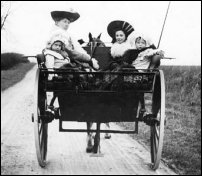 Yes. A Governess cart… if you think back to sort of Victorian/ Edwardian days, it’s a little cart that had quite high sides. It had a little door at the back that you opened so you would put the children in there and you would lock the door and usually the door doesn’t open from inside. It only opens from the outside like most carriages do. All the royal carriages that are in use, you can’t open them from inside. They can only be opened from outside and this was so that the children couldn’t actually open the door because the governess would be driving the Governess cart. Now you might have got one of the nannies in the back with the children as well, quite possibly. And this is what the governess would drive the children round in if they were going round the estate for, maybe, their afternoon’s nature watch as part of their education… whatever… and they were called the Governess cart because, as I say, it was the governess who would be taking them out in it. And it was one of the main methods of transport that a lot of families had for their children in those times.
Yes. A Governess cart… if you think back to sort of Victorian/ Edwardian days, it’s a little cart that had quite high sides. It had a little door at the back that you opened so you would put the children in there and you would lock the door and usually the door doesn’t open from inside. It only opens from the outside like most carriages do. All the royal carriages that are in use, you can’t open them from inside. They can only be opened from outside and this was so that the children couldn’t actually open the door because the governess would be driving the Governess cart. Now you might have got one of the nannies in the back with the children as well, quite possibly. And this is what the governess would drive the children round in if they were going round the estate for, maybe, their afternoon’s nature watch as part of their education… whatever… and they were called the Governess cart because, as I say, it was the governess who would be taking them out in it. And it was one of the main methods of transport that a lot of families had for their children in those times.
So, anyhow, we had this but I couldn’t get a wheelchair in it. So then they developed something called a Jubilee cart. So we had one of those. We don’t have that now. And you could actually push a wheelchair up into that so it meant that as well as pushing a wheelchair through there was a seat for another driver to sit on. So you had two sets of reins so the person sitting in the wheelchair could actually be driving as well but the main driver could take over all control if it was necessary or half-and-half control. So that was lovely. That was a lovely time.
They don’t have driving in Charlton Park now? Is that right?
No. No, they don’t. I don’t actually know when that stopped. Certainly I started the group in ’74 and I ran it for ten years. It had taken a lot of convincing all the time to make people see that this was a very, very, very viable therapy. You had to try and prove that all the time but anyhow I’d had ten wonderful years and I thoroughly enjoyed that. I’d had many, many fantastic memories.
Audio Extract: Liz McDermott remembers driving in Charlton Park
Extract from interview transcript: Carol Kendall talks about the weight of riders
(An edited audio version of this extract maybe heard below)
What would you do in an average day? What sort of things would you do?
Well, we’d go down and collect the horses from Maryon Wilson Animal Park about nine o’clock, bring them up, groom them, get them ready. Thursday there are only nine riders but the other days there’s twelve to fifteen. And they’d all ride – a half an hour slot for each rider but some riders won’t tolerate half an hour. It depends on the disability. And others we could leave them on all day and sometimes the teachers wish we could! After the riding sessions the horses are ridden by non-disabled staff to keep them fit and active. Then they’re fed. We have the farrier come to shoe them every six to eight weeks, depending on what they’ve been doing. The vets – and twice a year they have a regular physiotherapy session because riding for disabled is hard on a horse, so they get a massage.
Why is it hard on a horse? Is it because they’re walking slowly?
No. Well, they are walking in a school round and round. They do trot but by nature of their work they are carrying unbalanced riders which does put a bit of pressure on them.
So all the weight is on them rather than the rider taking some of the balance?
Oh, yes. You have to be careful. You have to work out how much weight you’d add to a rider’s disability. It can be up to two stone. Their riding weight can be up to two stone heavier than they actually are and if you put more than that then you wouldn’t ride because we’ve got to be able to get them off in an emergency, but that wouldn’t mean they can’t ride. We’d send them to a driving yard where they can actually drive a horse and cart.
Audio Extract: Carol Kendall talks about the weight of riders
Extract from Interview Transcript: Carol Kendall talks about a horse that couldn’t speak English
(An edited audio version of this extract maybe heard below)
Where do the horses come from –
They came over from Ireland. Arthur, about two and a half months ago, was in County Donegal. I don’t know where Ted came from but he was an Irish horse as well. The Irish horses are just really our type of horses. They have something about them. Something calm and…
Yes, they seem very gentle, don’t they?
Yes. Yes, they are…
Tolerant.
Honey – the chestnut – she’s a Haflinger and she was born and bred in Holland.
What’s a Haflinger then?
It’s a breed. It was bred for the Austrian army to go over the mountains and carry their packs. Anyway, she came over and she worked for the six weeks in a holiday camp, a children’s riding holiday centre, so, if you imagine the turnover of children! None of them were saying the same thing to her. I bought her because she is good but I thought, ‘Oh, dear! She’s dopey.’ I really couldn’t work out what to do with her. She didn’t know how to go up the mounting block. She was just a bit vacant and I thought, ‘I’m gonna have to move her on.’ And then, all of a sudden, I took her to the mounting block the wrong way round and she knew what to do.
When you say the wrong way round what does that mean?
If you imagine you mount a horse – if you were out on the road you’d mount it from the kerb so that’s called the nearside. Well, I took her to the mounting blocks over to the offside, which you wouldn’t normally mount from, and she knew to stand to be mounted from that side. She came from Holland where they do everything on the other side and the reason she was looking at us vacant was she couldn’t speak English and we just presumed she could. And then I got my friend Avril, who keeps her boat moored in Holland, to come over to chat to her and this horse went, ‘Thank God for that!’ And it was amazing. So we went through teaching her English, teaching her the English way to do everything and, obviously, she’s bilingual now.
Audio Extract: Carol Kendall talks about a horse that couldn’t speak English
Extract from Interview Transcript: Liz McDermott remembers a few risks
(An edited audio version of this extract maybe heard below)
Particular stories? Well, Steve Knight, he was a bit of a renegade, and you’d say, “Now look, Steve. I want you to go and… Are you listening to what I’m saying?” Yes, he was listening – he was listening but he was quite a tearaway. I said, “Now, look we’re going to let you have a jump-free. You’re not going to be on a leading rein. We’re gonna let you go.” And it was only a small jump but, of course, small jumps are mountains to these people. I mean, everybody has their personal Everest and this was a personal Everest for him.
So we said there will be somebody running near to you – “I don’t want anybody by my side.” I said, “Well, there will be. They will not be going over the jump with you and what-have-you.” And I can remember setting this pony off. You know, I thought, ‘Dear oh me. What’s gonna happen?’ Anyway, he got – foot reins and all… all over the… arms all… oh!! But he jumped it and the expression on his face was just fantastic. Achievement. Absolutely wonderful.
And then of course, there was the one that went wrong. We had a little Indian boy who had polio and he just loved riding but his balance in the saddle was not good to say the least but it didn’t impair him. Well, he fell off and it was very obvious to me what he’d done when he fell off. He’d broken his collarbone so we didn’t make too much of a fuss about this and he was fine. He was alright. So I said, “Don’t worry about it. It’s fine. We’ll go in and we’ll get a Sister from school and we’ll take you up to the hospital, get an x-ray and what-have-you.” But I said, “The problem is that you have broken it but lots of people do this when they’re riding. Lots of riders. You don’t need to worry about it.” I said, “I’ll just put it in a little sling and we’ll take you up to hospital.” And he was absolutely fine.
Those were the days when you took them in the car up to the hospital. Oh, my goodness me. Got him up to the hospital and he was chattering away like mad to me, not too bothered. We walked into the hospital, walked into the x-ray. That was The Brook at the time and we went in there and we were sitting chatting and he had his x-ray. (Laughs) He was fine, and then his mum and dad arrived and he just burst into tears because everyone else burst into tears! And I thought, ‘What is this all about?’ You know, brought this child up from school, there’s not been a tear in sight! Anyhow, but he was fine and he carried on riding when it had mended. I think those were the two things that stick out. There was lots and lots and lots of lovely things. Every day was a joy.
Audio Extract: Liz McDermott remembers a few risks
In Memoriam
There is a special place in Charlton Park that commemorates the life of Anthony (Tony) Hoare who died following a violent attack on the evening of September 6th 2007. A true gentleman, Tony brought into play the full meaning of community and village life to Charlton and is still sadly missed. Tony would have had some brilliant and funny stories to tell but instead we remember his life in Charlton. A candlelit vigil was held in the Park on the night of September 18th 2007 when friends and family gathered around his home in Kinveachy Gardens and walked along Charlton Road to Charlton Park. The Reverend Kes Grant said a few words and commented that “Tony would have been gobsmacked to see so many people tonight, he was such a humble man”.

